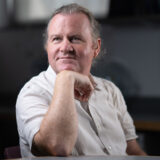David Nice

Professor of physics and department head
Degrees
- B.S., California Institute of Technology
- M.A., Ph.D. Princeton University
My Love Of Teaching
In college, I was drawn to physics because it uses a small number of rules to explain, well, everything. For example, electricity and magnetism might seem to be complicated, unrelated phenomena: What could a lightbulb have in common with a refrigerator magnet? By the mid-19th century, all aspects of both electricity and magnetism were understood to be completely defined by four interrelated mathematical laws. Then Einstein came along and showed that these can be further reduced to one simple rule (the attraction of particles of opposite charge) and an understanding of how space and time work (his theory of special relativity).
As a graduate student, I was drawn to astronomy because it uses simple rules in exotic applications. My thesis work involved radio telescopes, signal processing, neutron stars, and binary orbits. Each topic is immensely complicated, but at its core each has just a few key concepts.
After graduate school, I expected to pursue a research career. However, I was asked to teach an advanced course in my research field. It was daunting—it is a real challenge figuring out how best to teach material—but also highly rewarding. Few things are as satisfying as sharing interesting and exciting material with students.
Over time, I found the greatest satisfaction in undergraduate introductory and intermediate classes. My job is to figure out how to strip material down to core concepts, how to help students learn those concepts, and how to help students build up a framework to apply these concepts.
One of my favorite classes to teach is Lafayette’s first-semester course on spacetime, relativity, and contemporary physics. We developed this course to put modern physics at the forefront of our curriculum; to create a level playing field for students of all backgrounds; and to develop a sense of community among our students.
My Research Interests
I study millisecond pulsars. These stars are more massive than the sun, but only a few kilometers in size, and as dense as atomic nuclei. They rotate hundreds of times a second. Pulsars emit beams of radio waves, much as lighthouses emit beams of light. As a pulsar rotates, its beam sweeps past Earth, hitting it with a pulse of radio waves, once per rotation of the pulsar. I use large radio telescopes, such as the Green Bank Observatory [greenbankobservatory.org], to measure when these pulses arrive at Earth, a process called pulsar timing.
Traveling at the speed of light, the pulses take thousands of years to reach Earth. Pulsar timing lets us detect tiny changes in the distance between the pulsar and Earth. This lets us measure things like subtle relativistic effects in the motion of pulsars in binary systems and miniscule changes in spacetime around the pulsar and Earth due to the passage of gravitational waves.
I work in the NANOGrav Physics Frontiers Center [nanograv.org], a collaboration of almost 200 scientists who work to characterize gravitational waves via their effects on pulsar timing on timescales of many years. Our work is supported by the National Science Foundation. We recently found evidence that the universe is permeated by a ‘background’ of gravitational waves, which likely originate from supermassive black holes orbiting each other in distant galaxies. This finding came from 15 years of very precise data from three of the world’s largest radio telescopes.
Read more about this work here:
- Astrophysical Journal Letters
- Lafayette News
- NANOGrav website, with links to popular articles
Why Lafayette?
I came to Lafayette because I want to focus on teaching undergraduate students. I want to teach at a small school where I know my students well. I want to show them the excitement of physics. I want to teach them useful skills. I want them to work on cutting-edge astronomy research projects, and even though my research program uses some of the largest telescopes in the world, it can thrive in Lafayette’s small-college environment.
Personal Interests/Community Work
When I am not in the classroom, or in the lab, or spending time with my family, you might see me jogging along the canal towpath south of Easton. If it is the weekend, maybe we will go on a family hike: Delaware Water Gap and Pulpit Rock-Pinnacle loop are two of my favorite hiking spots near campus. If it is the summer, maybe we will take off to the Rockies or to somewhere farther afield in the world.